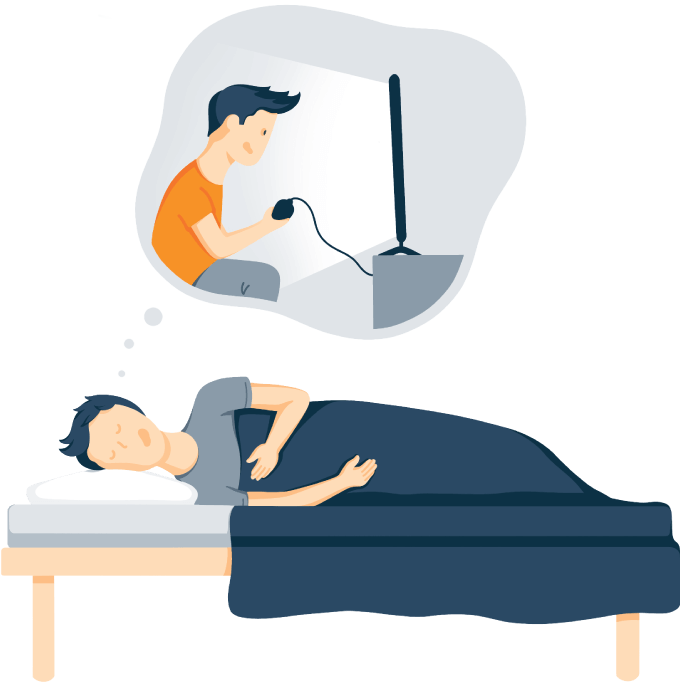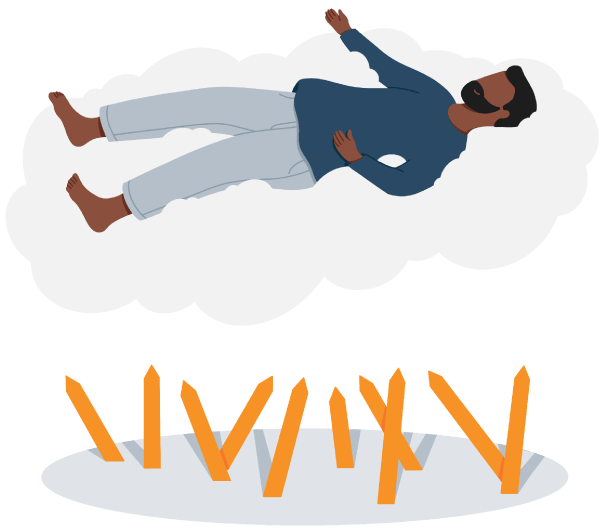Imagine being able to control your dreams while you sleep. You can try every food on the planet, travel the world, hang out with celebrities or lost loved ones, and maybe even have an existential conversation with your dog. All of this is possible once you learn how to lucid dream.
In this article, we’ll share proven tips on how to induce lucid dreams. While it is a skill that you’ll get better at over time, we’ve got some tricks that can help you have a conscious dream as early as tonight!
Hello friends! Since you are visiting this page, we want to ask you a few questions about Lucid Dreaming for research purposes:
What Is Lucid Dreaming?
A lucid dream is a conscious dream1. When you’re in this state, you can control yourself in a dream and explore a whole new world. The amount of control you are able to exert during lucid dreaming varies, but at minimum, you’ll be walking through a world painted by your subconscious mind totally aware that you are in a dream.
There are two types of lucid dreams:
- Dream-initiated – This is when you become conscious during your dream state and know that you are dreaming.
- Wake-initiated – You go directly from being awake into a lucid dream. This type is more controllable and can be planned for with a little practice.
Find Out More: The Science Behind Dreaming
Lucid Dreaming Induction Techniques
The first step is to learn everything you can about how to lucid dream. Fortunately, you’re in the right place, as this article has everything you need to get started. If you’re a beginner, keep practicing. Many people experience their first lucid dream within the first few nights of trying the techniques mentioned in this article.
Conduct Reality Tests
As you’re learning how to lucid dream, start with 25 reality tests each day, and you can decrease them as you get better at this skill. Here’s one to try:
- Look at one of your hands.
- Using a finger from your other hand, try pushing it through your palm.
- If you’re awake, your finger will touch the surface of your palm, but if you’re lucid dreaming, it will go through it.
The purpose of reality checks is to perform a simple action that proves you’re awake. The outcome of the action will be different whether you’re awake or asleep. If you repeat this action multiple times each day, it becomes a habit that your dreaming mind will pick up. Then, when your body does this task in a lucid dreaming state, you’ll be primed to pick up on the fact that you’re asleep.
Turn off All Screens
At least one hour before bed, turn off all electronic devices with lit screens. Your bedroom must be as dark as possible to encourage melatonin production, the hormone that helps you sleep. Since light interrupts melatonin production, it’s important to keep your environment dark.
Set an Alarm
Set an alarm for five hours after you go to sleep. Ideally, the alarm should go off between 4:00 a.m. and 6:00 a.m.
The idea is that the alarm will wake you during rapid eye movement (REM) sleep, and you’ll fall right back asleep. You’ll use the techniques in the next steps to make sure that you enter a lucid dreaming state.
Two things to note on this step to ensure success:
- The alarm sound should be soothing. While it needs to wake you up, a blaring noise, incessant buzzing sound, or obnoxious ringtone is too jarring. Opt for nature sounds or something pleasant.
- Do not open your eyes when you turn off the alarm. Keep the alarm close enough so you can easily reach it.
Wake Up with Your Eyes Closed
Even though you’re waking up for a moment, keep your eyes closed. You’re preparing your body to go back to sleep even though your mind will still be semi-awake and active.
Perform a “WBTB”
The abbreviation is short for “wake back to bed.” As you wake up from a deep sleep, you’ll be training your body to fall back asleep while still keeping your mind alert.
So, now you’ll start to feel your body drift off to sleep. Your body may trick you into revealing your mind is awake by performing a sleep test. The body will send a message to your brain that you need to roll over, touch your stomach, scratch your nose, etc. Resist the urge to move.
Once your body is sure you’re asleep, it will relinquish control, and you’ll begin to see colors, shapes, and even glimpses of scenery. You’re now in a lucid dream.
Lifestyle Tips for Lucid Dreaming
Meditate
In the last section, we alluded to the separation between mind and body. Meditation, when done correctly, helps you practice this skill.
For example, you may have seen Buddhist monks meditate for hours on end. They can achieve that because their bodies have gone to sleep, yet their minds are awake. Lucid dreaming is very similar and requires the same skill set.
Interested in more details? Learn how to meditate before sleep.
Listen to Binaural Beats
You might have listened to binaural beats to help you focus, study, and even sleep, but they can also help with lucid dreaming, too. The two frequencies being played at the same time enter each ear individually and are processed by your brain as a single frequency that merges the two.
You can find binaural beat tracks for free on YouTube, or you can purchase an app for more variety. The trick to making these work for lucid dreaming is to match the Hz (frequency) to the appropriate brainwaves to encourage the activity. In this case, you want Theta waves, which are between 4Hz and 8Hz.
Play Video Games
When you play video games, you immerse yourself in a new world and can explore the edges of this new universe. Push yourself to explore new lands while you’re in play mode, and you’ll be more primed to do it while you’re sleeping.
Take Galantamine
Galantamine is a natural supplement often recommended to Alzheimer’s patients to improve brain activity and memory function. The substance is commonly found in plants like dandelions, and it’s commercially extracted for oral use from flowers like the spider lily.
Studies have shown2 that this supplement helps lengthen REM sleep and encourages sleep recall. In this particular study, the likelihood of a lucid experience was 5.8 times higher than when the participant took a placebo.
Take Vitamin B Supplements
Vitamin B6 is associated with lucid dreaming. The link between ingesting this vitamin and entering a conscious dream hasn’t been fully developed yet, but this study3 suggests that the increase in serotonin levels from this supplement makes nightly visions more vivid and colorful.
The Benefits of Lucid Dreaming
Choose Your Dream
You are no longer bound by nonsensical dreams about seemingly random occurrences throughout your day. Instead, you choose what visions you want to see when you go to sleep. Our subconscious is a powerful system, so even if you’ve never been to Paris, you’d be surprised by the level of detail your mind will create.
Increase Creativity
The only limit of lucid dreaming is your imagination. When your conscious and subconscious minds work together to create a new land, you’ll be amazed at what you can do. Maybe you’ll even think of a remarkable, life-saving invention. Along with boosting creativity, your lucid dreams could also help spark inspiration. Whether it’s starting a nonprofit or writing a song, these dreams could present some wonderful opportunities.
Reduce Fears
This is an ideal time to confront your fears because there are no consequences. Nothing can hurt you during a dream. If you’re afraid of heights, have a dream about skydiving! If public speaking makes you anxious, create a reality where you give a speech that receives a standing ovation.
Improve Motor Skills
If you want to get better at something, like playing a musical instrument, dreaming about the activity is an effortless way to “practice” and improve. By lucid dreaming about the skill you’d like to learn, you’ll find that you master it much faster if you incorporate practice time into your dreams.
Control Your Nightmares
Once you master lucid dreaming, you can also master lucid nightmares. A lucid nightmare is the unpleasant version of a lucid dream. The good news is that since you are aware of the situation, you can take a more active role in the situation and confront whatever is causing the nightmare.
For example, if you’re being chased by a fire-breathing dragon, you no longer have to play the role of the victim. Instead, conjure up your sword, turn around bravely, and slay that dragon.
No matter how horrific a nightmare you’re having, once you master the art of lucid dreaming, you’ll be able to control the situation or at least find comfort in knowing that nothing can hurt you.
Get More Info: How To Avoid Nightmares
Lucid Dreaming Dangers
More Disrupted Sleep
Research has found that lucid dreaming could be linked to more fragmented sleep4 patterns. Fragmented sleep means that you wake up from sleeping multiple times throughout the sleep. This can be dangerous for your overall health because interrupted sleep is associated with higher blood pressure5.
May Affect Mental Health
Lucid dreaming could also have an impact on your mental health. In some cases, this can be a positive thing. For example, lucid dreams may reduce anxiety caused by nightmares. However, for patients with psychosis, which is when someone disconnects from reality, lucid dreaming could make things worse. Researchers from one study6 suggest that psychosis patients who practice lucid dreaming may experience more deliria and hallucinations.
Conclusion
Lucid dreaming is a fascinating topic, with lots of varying research behind it. There are cases for lucid dreams, such as those who say they could improve motor skills, help with nightmares and anxiety, and boost creativity. On the other hand, there are potential drawbacks to it, including fragmented sleep and negative mental health implications in certain populations.
If you’re interested in trying out this type of controlled dreaming, we recommend first assessing if it’s a healthy option for you. Then, if it’s safe to move forward, you can test out some of the techniques we’ve covered. Don’t get discouraged, as it can take some time to master this ability, but once you do, you could see some impressive results.

Julia Forbes
Lead Product Tester
About Author
Julia is the Lead Reviewer at Sleep Advisor, specializing in testing out mattresses and sleep accessories – she’s in the right line of work, because she loves to sleep.
Stomach Sleeper
References:
- Brogaard D.M.Sci. Ph.D, Berit. “Lucid Dreaming and Self-Realization”. Psychology Today. 2012.
- “Galantamine: Reviewing The Lucid Dreaming Pill”. Dream Studies Portal. Webpage accessed October 18, 2024.
- Ebben, Matthew., Lequerica, Anthony., Spielman, Arthur. “Effects of pyridoxine on dreaming: a preliminary study”. National Library of Medicine. 2002.
- Gott, Jarrod., et. al. “Sleep fragmentation and lucid dreaming”. Consciousness and Cognition, Volume 84. 2020.
- Morrell, MJ., Finn, L., Kim, H., Peppard, PE., Badr, MS., Young, T. “Sleep fragmentation, awake blood pressure, and sleep-disordered breathing in a population-based study”. National Library of Medicine. 2000.
- Mota, Natália B., Resende, Adara., Mota-Rolim, Sérgio A., Copelli, Mauro., Ribeiro, Sidarta. “Psychosis and the Control of Lucid Dreaming”. Frontiers in Psychology. 2016.






